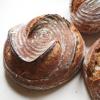
Altamura Sourdough - A Happy Accident
Every once in a while, things don't go exactly as planned, but the result is really good anyway. This is one of those times - a happy accident.
I promised to bring some bread to a dinner party with friends. I made a delicious loaf of David's San Francisco sourdough, and I wanted to make a durum flour loaf, like Leader's Pane di Altamura. I also wanted to try a loaf shaping technique that I saw in this video. [I think the original reference to the video was posted recently on TFL, but I can't find it, so my thanks to the poster and my humble apologies for not being able to give credit.] Having never tried either the recipe or the technique, and reading some posts on TFL about some problems with Leader's formula, at the last minute I decided to bail and modify the recipe to one I felt a little more comfortable with.
I had already built the levain in three stages and was ready to mix the dough. I started with my stock 100% hydration starter, and converted part of it to an 81% H using whole wheat durum as the first refreshment (formula below in the "Method" section). A second refreshment was done after fermenting overnight, and the final build was mixed after 13 hours and left to ferment again overnight. I found the whole wheat durum peaked too quickly (6-7 hours), so for the final build I switched to Extra Fancy durum. This was beautifully peaked and full of gas bubbles the next morning (sorry, no pics).
After looking at some past Altamura-type loaves that I had baked in the past, I decided on a 40% AP flour/60% Durum blend for the final dough. It turned out to be fairly easy to work with, even though the final hydration was in excess of 70%. The dough had excellent structure, but when it came time to score the loaves, I found that it was too wet a dough to score like in the video and the result is the top loaf in the photo below. It was scored with the baker's knife, but the dough was too wet to coax up the corners into the desired peaks. The second loaf was scored with a lame.

The oven spring was so huge you can barely see the score in the bottom loaf. It was also underproofed, but overall look didn't suffer too badly. The crumb was extremely moist and chewy with lots of irregular sized holes. The crust was also chewy, perhaps a bit too soft for my tastes, but the overall flavor was very good.

Here's the formula and method. [Note: this formula is revised based on discussion below.]

I think that in order to be able to shape as in the video, the hydration needs to be in the 60-65% range. I will definitely try this again.
-Brad


Comments
I definitely want to try your approach. Thanks for the link to the video. -Varda
Please let me know what you learn!
-Brad
...that makes anyone who sees it want to make it.
Happened to me, happens seemingly to everyone. I should try my hand at it again, now that I sorta' know what I'm doing. Past attempts have made Altamura bricks. I call it The Beast of Altamura.
If I can make one that looks as good as yours, I'd be happy.
Question: I've had too much beer to look at the math too closely, but if your overall is [2440 g] and your final (which includes the starter) is [2139 g], where's the other 301 g? And why's the starter in the overall 405 and the starter column 422? I'm probably missing something obvious.
Thomas, a very good catch. I adjusted my original spreadsheet to account for the Seed starter, which previously I had not included, and what I posted was an unverified version.
First: the easy question. I start with 422 gm of starter, but after fermentation and loss during transfer, I get only 405. Where is it going? I assume some is evaporation, some is transfer loss, and some is from the CO2 evolved during the fermentation. For whatever reason, as an engineer I tend to measure each component at each step rather than assuming that all gets transferred. It's a bit over the top for baking, I realize, but these are habits developed over years doing semiconductor process development.
Second: why the discrepancy between the overall and the final. Apparently, I double counted the starter both in the individual components and again as the full starter. If you take out the 405 gm from the Overall column, you get 2440-405=2035 gm, then add back the seed, you get 2035+121=2156. Deducting the starter loss between the 422-405 = 17gm, 2156-17=2139gm, voila, all is accounted for. I apparently took out the wrong cell from my calculation and I have posted a correction, although I removed the row for seed starter until I figure out how to deal with it properly. My spreadsheet makes this too cumbersome. Thanks for pointing out the error.
I am working on a sort of hybrid between your BBGA spreadsheet and one that tells me more of the information that I am interested it. Please stay tuned.
-Brad
Those transfer changes in mass are real. I notice it even with water (2 g loss to the bowl).
I try to limit them by measuring everything in one bowl, but you can't really do that with starter, etc.
And if we use 57.1234234% in our spreadsheets, why don't we pay more attention to the transfer error?
We trust these too much:
I sent an email to the BBGA about publishing more info. on their formula format. I'm rather afraid to 'wake the sleeping giant'. What if they realize people are using it off-site and try to take it back?